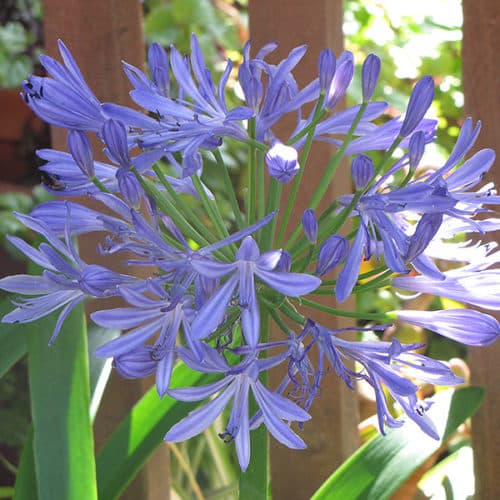Seasonal Agapanthus Treatment: Getting Ready For Wintertime and Summertime
Seasonal Agapanthus Treatment: Getting Ready For Wintertime and Summertime
Blog Article
Mastering the Art of Agapanthus Care: Important Steps for Healthy Growth and Lively Blossoms
In the world of gardening, the growing of agapanthus stands as a satisfying venture for those who look for to support these stylish flowering plants. From picking the ideal selection to grasping trimming strategies, the journey towards cultivating growing agapanthus plants is diverse and holds the crucial to unlocking the full possibility of these herb treasures.

Selecting the Right Agapanthus Variety

When choosing the appropriate Agapanthus variety for your yard, take into consideration factors such as environment viability, bloom color, and growth habit. Agapanthus, commonly known as Lily of the Nile or African lily, comes in a variety of colors varying from tones of blue and purple to white. Choose a flower color that enhances your existing yard combination to produce a harmonious landscape. Additionally, consider the climate in your area to guarantee the Agapanthus range you pick can prosper in your particular conditions. Some varieties are extra forgiving of chilly temperature levels, while others favor warmer environments. Comprehending the growth behavior of various Agapanthus ranges is crucial for correct positioning within your garden. Some selections have a clumping growth habit, perfect for boundaries or containers, while others have an even more dispersing nature, suitable for ground cover or mass growings. By carefully reviewing these aspects, you can choose the perfect Agapanthus selection to boost the beauty of your garden.
Perfect Planting Conditions
Taking into consideration the optimal ecological requirements is essential for successful Agapanthus farming. Agapanthus plants are delicate to chilly temperature levels and need to be shielded from frost throughout wintertime months.
To make certain healthy and balanced growth and lively blooms, plant Agapanthus light bulbs at a deepness of about 2-4 inches and room them 8-12 inches apart. Mulching around the base of the plants helps keep moisture and reduces weed growth.
Watering and Feeding Tips
Keeping proper dampness levels and offering important nutrients are crucial aspects in the care regimen for Agapanthus plants. When it comes to watering Agapanthus, it is essential to strike a balance. These plants favor constantly damp dirt but are at risk to root rot if overwatered.
Feeding Agapanthus is important for advertising healthy development and respected flowers. Use a well balanced plant food, such as a 10-10-10 formula, in the very early springtime as new development arises. By adhering to these watering and feeding ideas, you can guarantee your Agapanthus plants prosper and generate lively, long-lasting flowers.
Pruning Techniques for Agapanthus
Trimming Agapanthus plants at the ideal times and with proper strategies is essential for keeping their health and wellness and promoting optimum growth and blooming. The excellent time to prune Agapanthus is in late winter season or very early springtime prior to new growth arises.
Deadheading spent flowers can additionally reroute the plant's energy into creating more flowers instead than setting seeds. If you desire to gather seeds for breeding, leave some flowers to fully grown and completely dry on the plant.
Remember to use tidy, sharp devices to make accurate cuts and reduce the risk of presenting conditions. Agapanthus. Regular pruning will certainly assist keep your Agapanthus looking healthy and balanced and neat while ensuring an abundant screen of attractive blooms
Dealing With Common Insects and Diseases
After making sure appropriate pruning methods for Agapanthus, it is vital to attend to usual parasites and conditions that can influence the health and wellness and vitality of these plants. One typical bug that Website impacts Agapanthus is the Agapanthus gall midget.
An additional common issue is fungal fallen leave area, which provides as dark lesions on the fallen leaves. To stop fungal illness, guarantee good air blood circulation around the plants, stay clear of above watering, and remove any type of contaminated fallen leaves quickly. Furthermore, Agapanthus plants can struggle with origin rot if they are planted in badly draining pipes dirt. To avoid this, plant Agapanthus in well-draining soil and avoid overwatering. By being alert and taking timely action versus bugs and diseases, you can help your Agapanthus plants prosper and create vibrant blooms.

Conclusion
Finally, grasping the art of agapanthus care includes picking the ideal range, giving perfect planting problems, appropriate watering and fertilizing, proper trimming strategies, and resolving usual bugs and diseases. By complying with these vital actions, you can make sure healthy growth and lively flowers for your agapanthus plants. Remember to frequently keep track of and maintain your plants to advertise their general wellness and longevity.
To guarantee healthy development and lively blossoms, plant Agapanthus bulbs at a depth of about 2-4 inches and room them 8-12 inches apart. By adhering to these watering read this and fertilizing tips, you can guarantee your Agapanthus plants thrive and produce lively, lasting flowers.
One usual bug that affects Agapanthus is the Agapanthus gall midget. Additionally, Agapanthus plants can endure from origin rot if they are planted in inadequately draining dirt. By complying with these over here essential steps, you can guarantee healthy and balanced development and vibrant blossoms for your agapanthus plants.
Report this page